Making Pancake Batter Without Milk: No Milk Pancake Mix
When it comes to making pancakes without milk, many options are available. Pancakes without milk? Absolutely. Whether you’ve embraced a dairy-free lifestyle, are navigating food sensitivities, or ran out of milk mid-recipe, there’s a world of alternatives waiting to elevate your pancake experience. A perfect substitute for milk in pancakes, it keeps the batter flowing and introduces a new dimension of flavor and nutrition to your morning stack.

Pancakes Without Milk
If you’ve ever found yourself staring into the fridge at an empty milk carton with a pancake craving that won’t quit, or you can’t do the dairy, you’re in the right place.
As someone who has flipped more pancakes than I can count and experimented with almost every liquid in the pantry, I’ve discovered that necessity isn’t just the mother of invention—it’s the secret ingredient to your new favorite breakfast.
For many, pancakes on fresh off of the griddle are a delightful way to start the day, offering a blank canvas for various toppings and flavors.
However, whether due to dietary restrictions, allergies, or simply a lack of milk at home, there comes a time when a milk substitute is necessary.
The absence of traditional milk doesn’t have to mean the absence of delicious, fluffy pancakes.
Finding the best substitute for milk in pancakes took work.
But it sure was delicious, so let’s break down the top 11 milk substitutes for pancake batter, ensuring your breakfast remains a staple at the table, regardless of dietary needs or pantry shortages.
Table of Contents
Why Use a Milk Substitute?
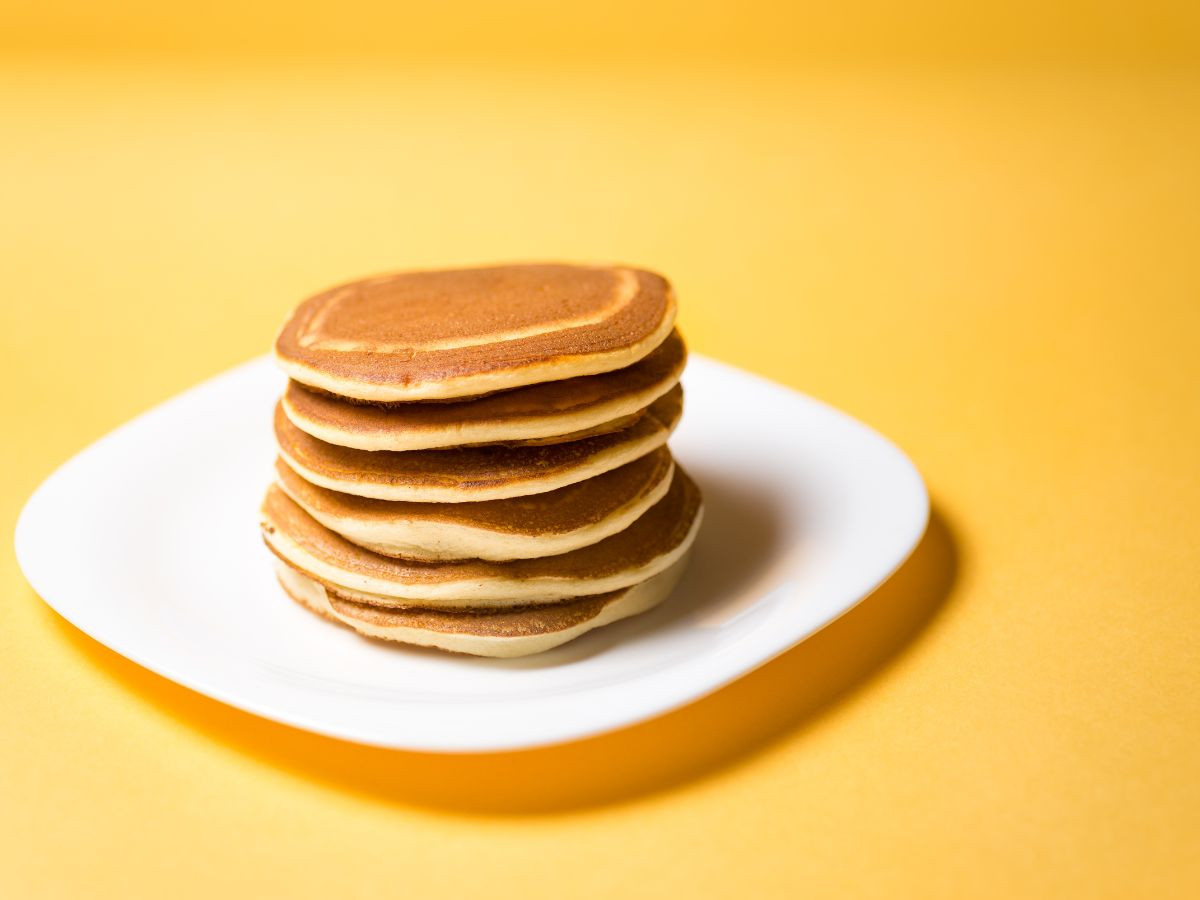
Milk is traditionally used in pancake recipes to add moisture, richness, and structure. However, several reasons might lead one to seek an alternative:
Dietary Restrictions: Those lactose intolerant and dairy allergies need non-dairy options.
Health Choices: Some prefer milk alternatives due to lower calorie, fat, or nutrient profiles (like added calcium or vitamins).
Flavor Variations: Substituting milk with other liquids can introduce new flavors to your pancakes.
Pantry Limitations: Sometimes, you might be out of milk when the pancake craving hits.
What Can I Use As A Substitute For Milk In Pancakes?
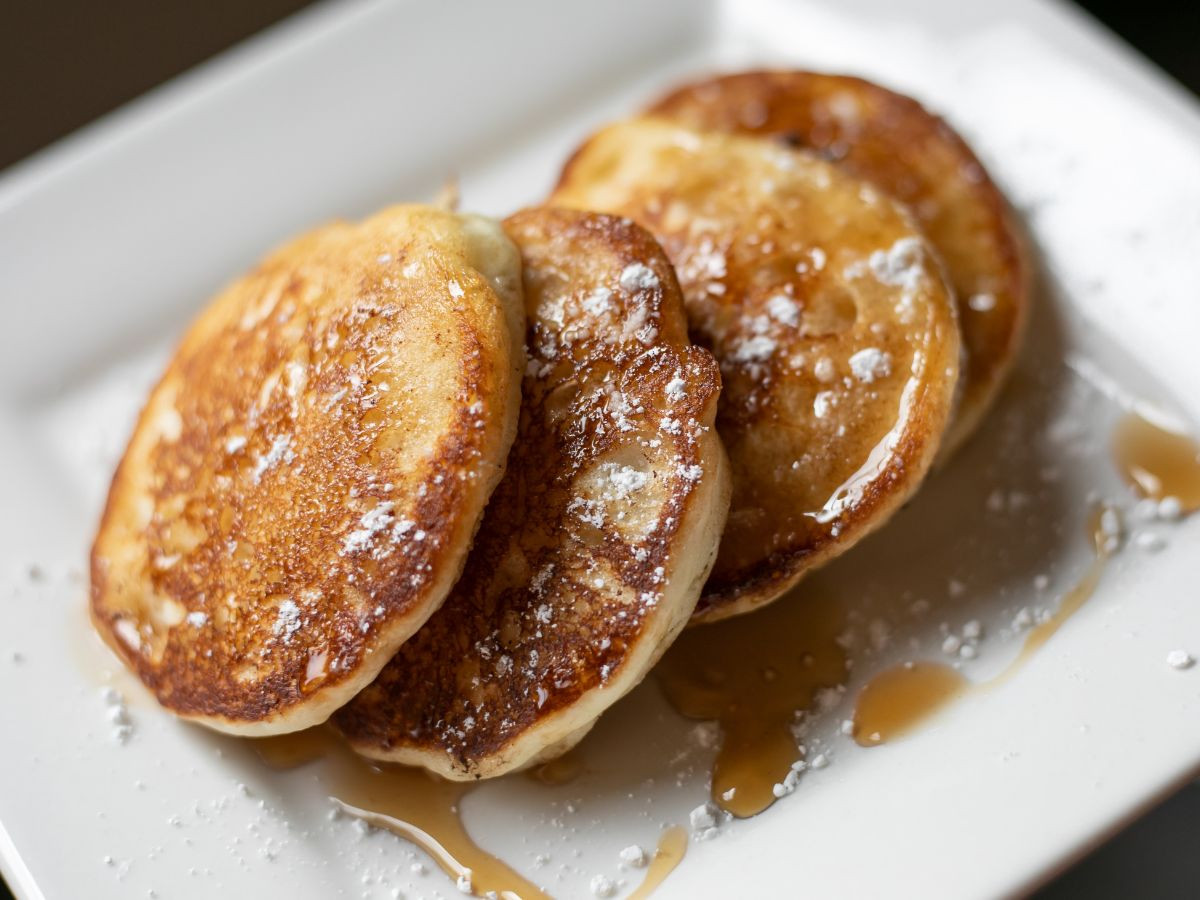
Navigating the world of milk substitutes in pancake recipes opens up possibilities, each with its flavors and benefits.
Whether you’re out of milk, managing dietary restrictions, or simply curious to try something new, these alternatives ensure that your pancakes remain a breakfast favorite.
With these 11 alternatives that I’ve tried and tasted over and over, your pancakes can be as diverse and interesting as your palate desires.
Each brings unique benefits and flavors, transforming your morning staples into something new and exciting.
1. Almond Milk: The Nutty Challenger

Almond milk stands tall when finding a milk substitute that’s almost as versatile as the original.
Its slightly nutty flavor brings a subtle twist to pancakes without overpowering your favorite toppings. Here’s why almond milk might just become your go-to:
Flavor Profile: It has a light, nutty taste that complements sweet and savory pancake variations.
Nutritional Benefits: Lower in calories compared to cow’s milk, almond milk is a fantastic option for those watching their intake. Plus, it’s naturally dairy-free and vegan-friendly.
How to Use It: Substitute almond milk one-for-one in any pancake recipe. If your batter seems too thick, add a tablespoon until you reach the desired consistency.
A personal tip?
For an extra fluffy texture, choose unsweetened almond milk to keep the sugar content in check, allowing you to pile on the maple syrup guilt-free.
2. Soy Milk: The Protein Powerhouse

Soy milk is a stalwart in the world of milk alternatives, and for good reason.
Its creamy texture and balanced flavor profile make it a strong contender for pancake recipes, ensuring your breakfast is delicious and packed with protein.
Flavor Profile: Neutral with a hint of creaminess, mirroring the consistency of whole milk.
Nutritional Benefits: High in protein and often fortified with vitamins and minerals, soy milk is a nutritional boon for anyone looking to boost their morning meal.
How to Use It: A direct 1:1 substitution works perfectly. Soy milk’s rich texture is ideal for creating tender, moist pancakes.
Cooking Tip:
Opt for unsweetened and unflavored varieties to maintain the classic pancake taste we all know and love.
3. Coconut Milk: The Tropical Twist
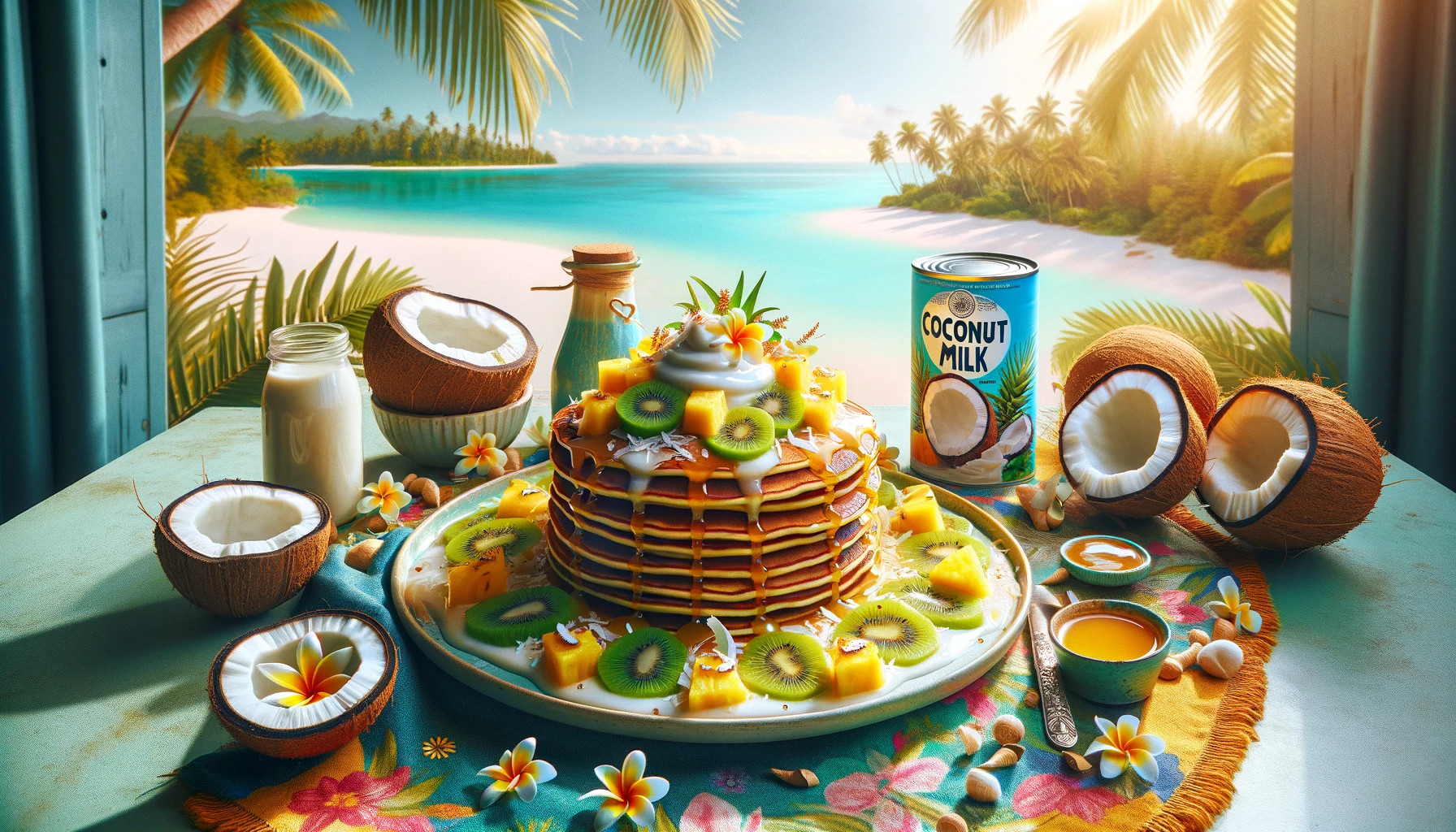
Craving something a bit exotic?
Coconut milk adds a luxurious richness and subtle tropical flair to pancakes, making every bite a mini getaway.
Flavor Profile: Slightly sweet and unmistakably coconut, it’s perfect for those looking to add a tropical twist.
Nutritional Benefits: Though richer in fat, coconut milk offers a unique composition of fatty acids believed to support metabolism. It’s also dairy-free, suiting various dietary needs.
How to Use It: Because of its thickness, start with less coconut milk than the recipe calls for, adding more to achieve your preferred batter consistency.
A quick chef’s note:
Canned coconut milk will give your pancakes a decadent, creamy texture, while carton coconut milk is lighter and more suited for everyday recipes.
4. Oat Milk: The Creamy Contender

Oat milk has surged in popularity, and it’s easy to see why once you’ve tried it in pancakes.
Its naturally sweet flavor and creamy consistency make it a dream ingredient for those fluffy stacks.
Flavor Profile: Mild and slightly sweet, oat milk can add a subtle oatiness that complements the inherent flavors of pancakes.
Nutritional Benefits: It’s a great source of fiber and can be enriched with vitamins and minerals. Oat milk is a fantastic alternative for those avoiding nuts or soy.
How to Use It: Oat milk can be swapped in one-for-one for cow’s milk. Due to its thickness, it helps produce a beautifully rich pancake batter.
Here’s a little chef’s secret:
If you’re after an even lighter texture, try using barista blend oat milk. It’s formulated to foam and froth in coffees but adds an extra lift to pancake batters.
5. Rice Milk: The Lightest Option
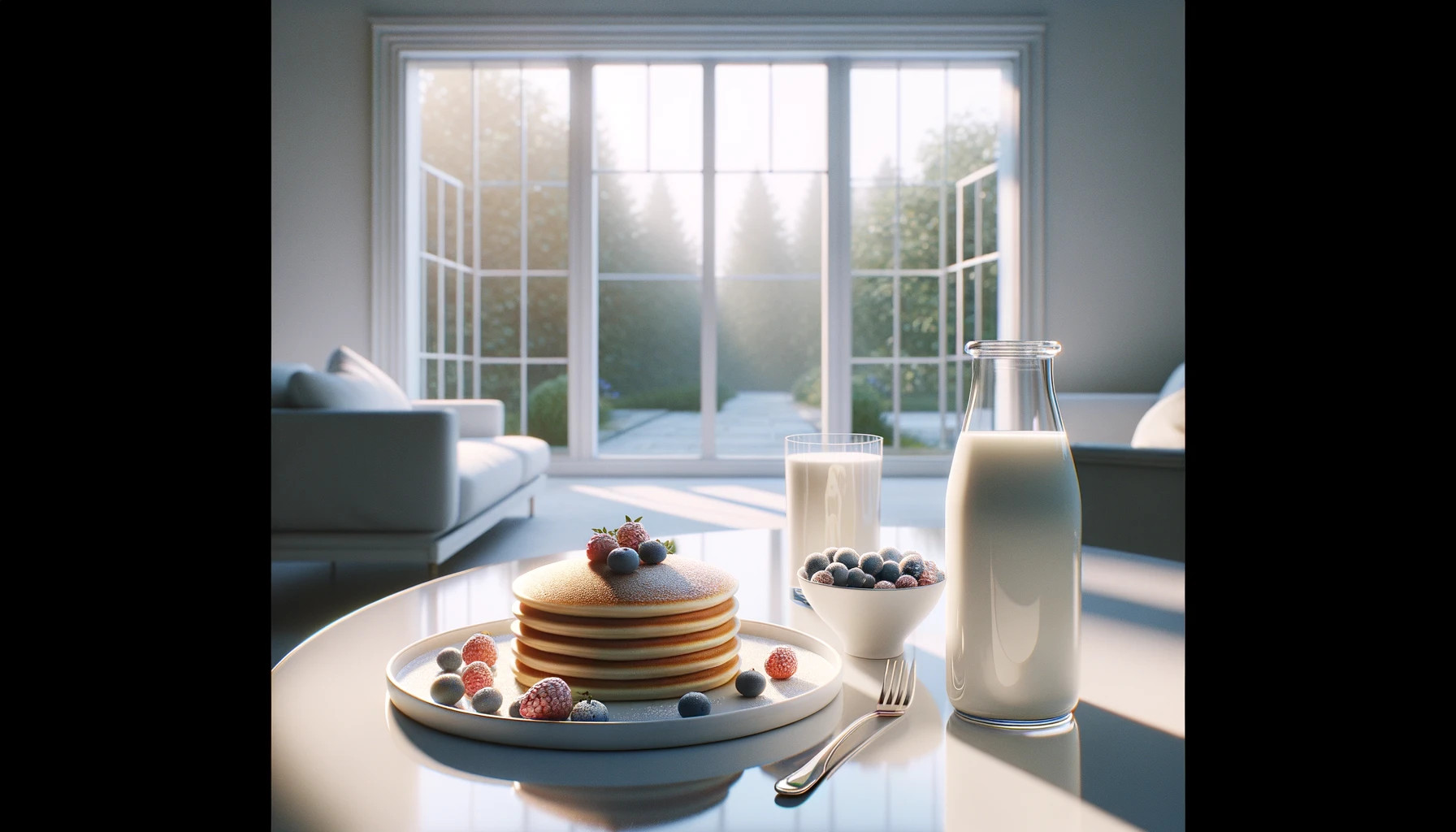
For those who prefer their pancakes on the lighter side, rice milk is the go-to.
It’s the most watery of the milk substitutes, making it perfect for a less dense pancake.
Flavor Profile: Subtly sweet with a very mild flavor, it’s the least intrusive of all milk substitutes, ensuring the primary flavors of your pancakes shine through.
Nutritional Benefits: Rice milk is the least allergenic of milk alternatives, making it an excellent choice for those with multiple food sensitivities.
How to Use It: Because of its thin consistency, you might need to adjust the amount slightly or add more flour to get the batter right.
One thing to remember:
While rice milk is great for achieving a lighter texture, consider adding a splash more to enrich the batter if you’re after that classic richness.
6. Cashew Milk: The Understated Luxury
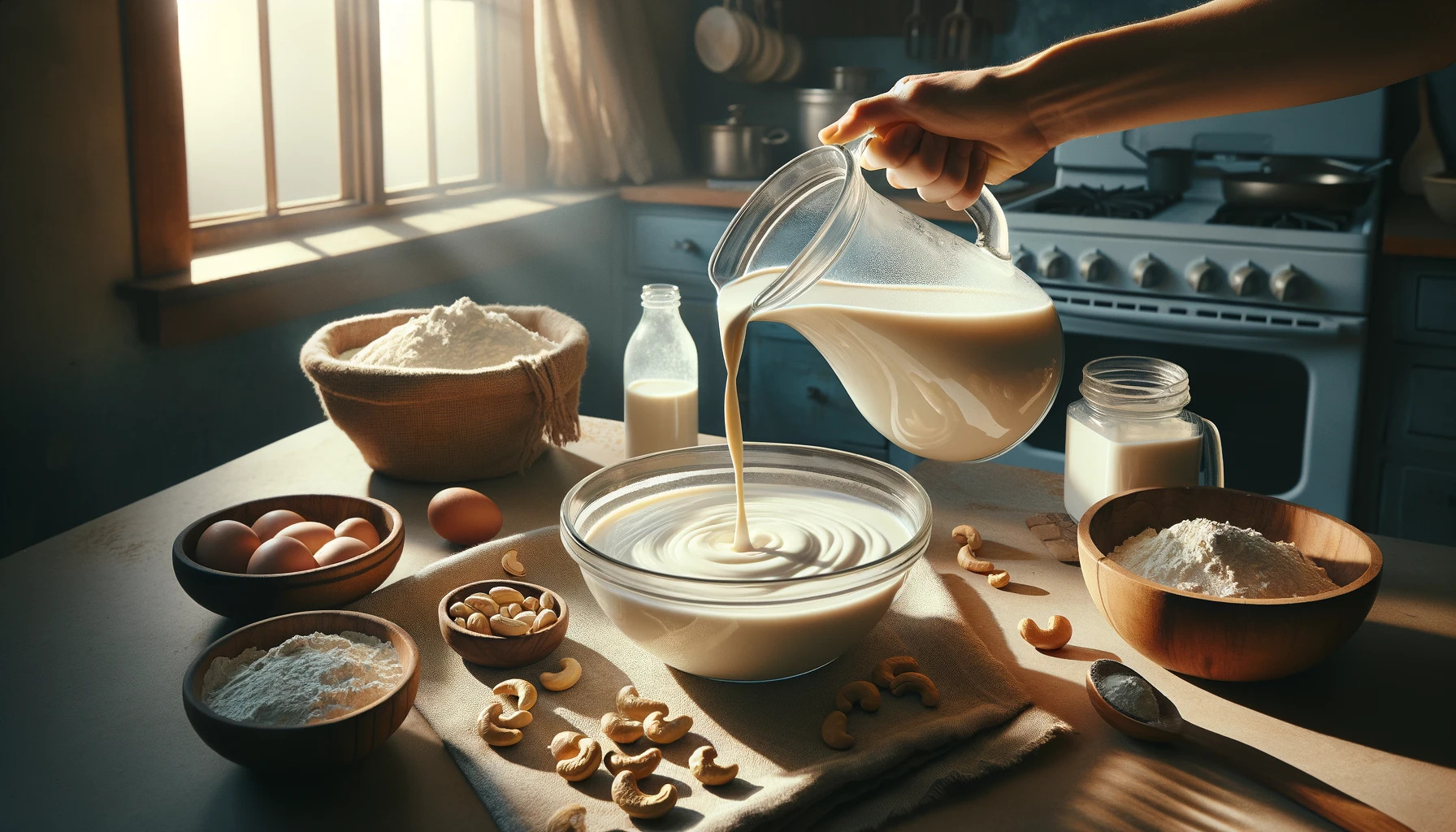
Cashew milk might not be as popular as almond or soy, but it’s a hidden gem in pancake recipes.
Its creamy texture and subtle sweetness add a luxurious feel to your breakfast.
Flavor Profile: Mild and slightly sweet with a creamy, luxurious texture.
Nutritional Benefits: Similar to almond milk but creamier, it’s also low in calories and a good source of healthy fats.
How to Use It: Use it one-for-one in any pancake recipe for a direct substitute that brings a touch of elegance to your plate.
Chef’s tip:
For an indulgent weekend treat, blend a handful of soaked cashews into your pancake batter for an extra creamy boost that’s naturally sweet and incredibly satisfying.
7. Hemp Milk: The Nutty, Earthy Alternative
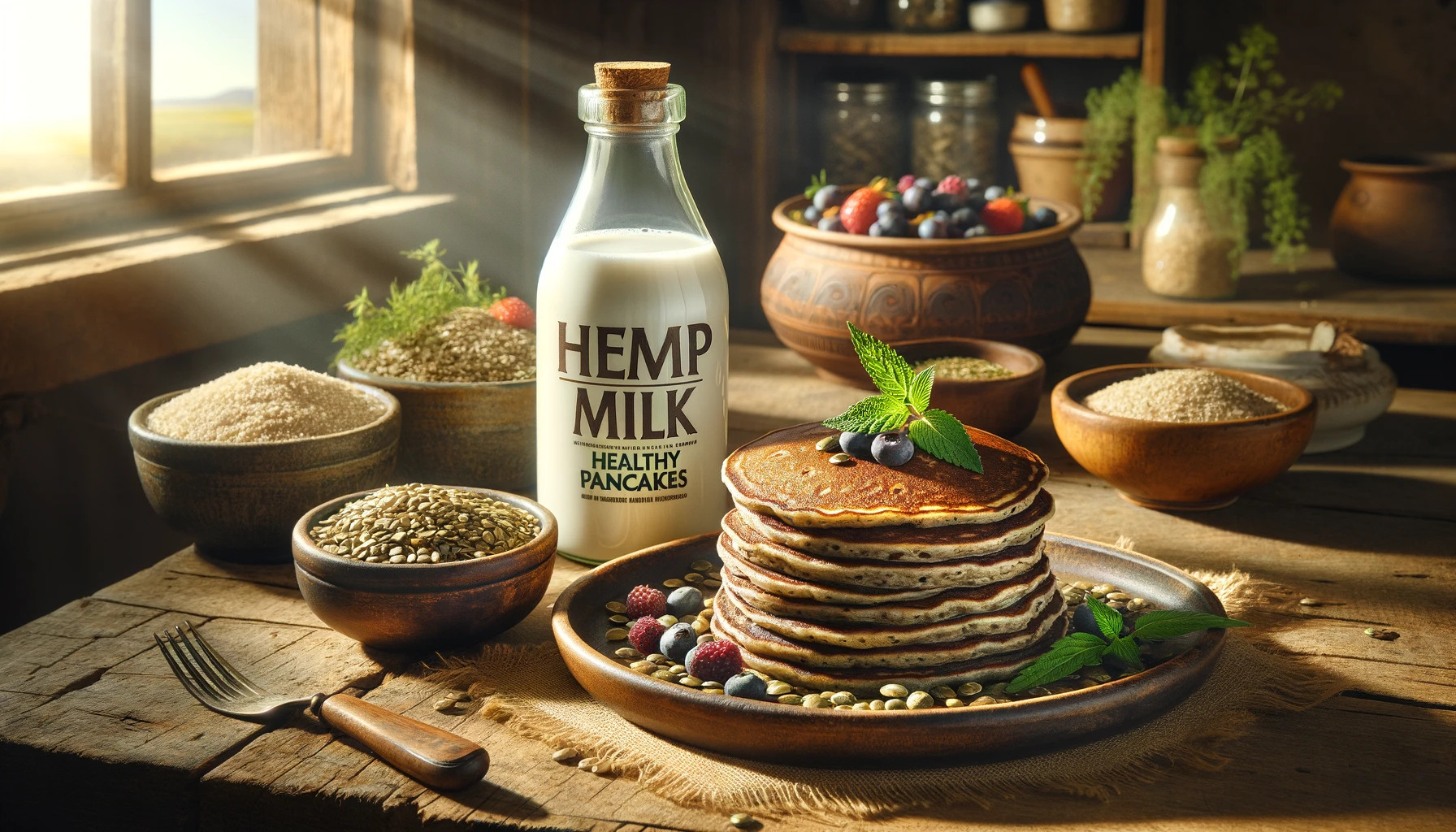
Hemp milk is making waves in the dairy-free community for its nutritional benefits and distinctive taste.
It’s a fantastic pancake addition for those looking for something different.
Flavor Profile: Hemp milk has a slightly nutty and earthy flavor, setting it apart from other milk substitutes. It adds a unique depth to pancakes that’s both intriguing and delightful.
Nutritional Benefits: Rich in omega-3 and omega-6 fatty acids, hemp milk is a heart-healthy choice. It’s also a good source of plant-based protein.
How to Use It: Substitute hemp milk one-for-one in your pancake batter. Its rich consistency contributes to a moist and tender pancake.
Tip from the kitchen:
If you’re experimenting with hemp milk for the first time, add a little vanilla extract to your batter to complement its earthy tones.
8. Flaxseed Milk: The Omega-3 Champion
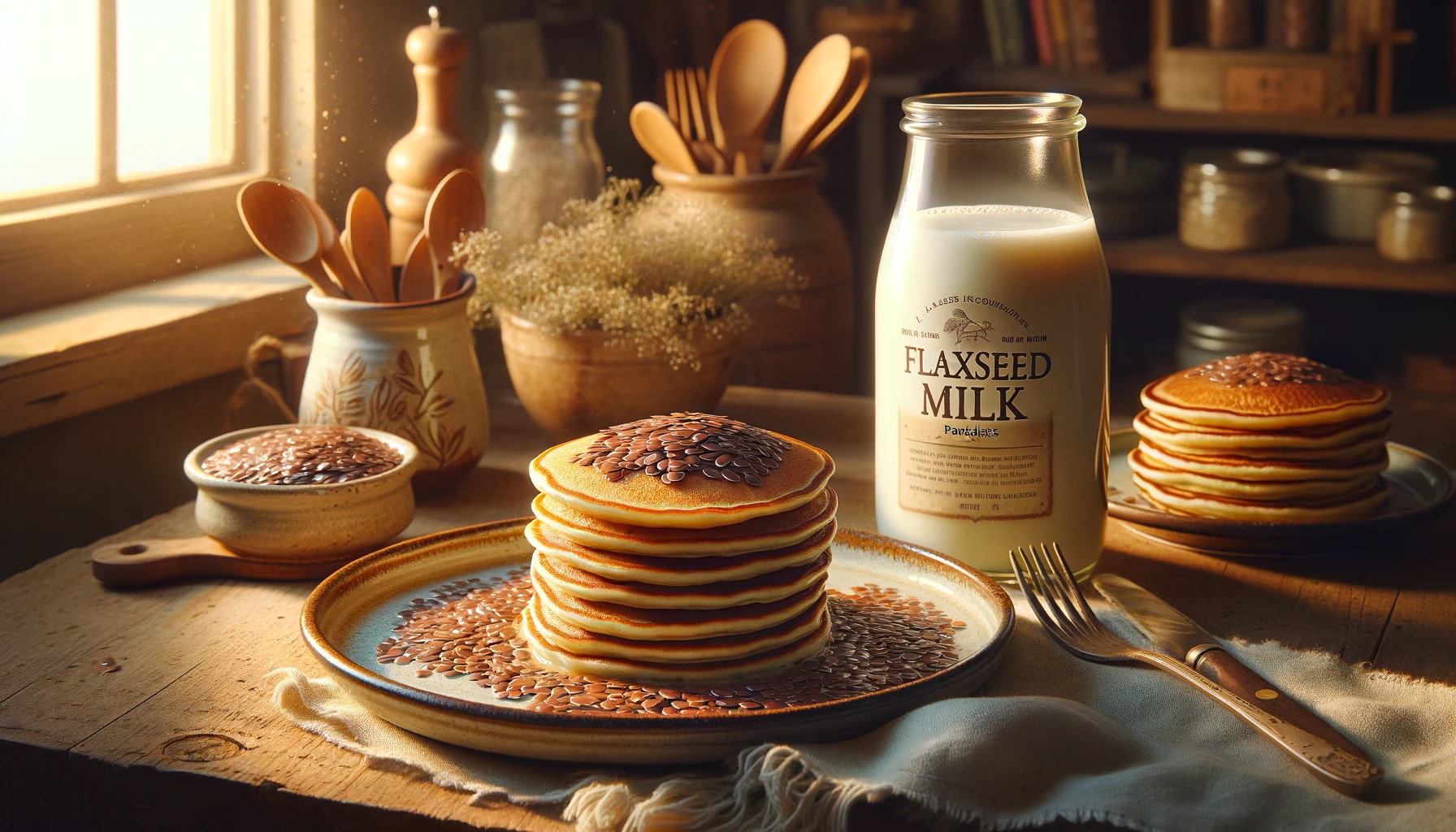
Flaxseed milk might not be the first option that comes to mind for pancakes, but it’s a powerhouse of nutrition and offers a slightly nutty flavor reminiscent of its seed origin.
Flavor Profile: With a mild, nutty taste, flaxseed milk can enhance the overall flavor profile of your pancakes without overwhelming them.
Nutritional Benefits: It’s high in omega-3 fatty acids, which benefit heart health. Flaxseed milk is also typically fortified with vitamins and minerals.
How to Use It: Like most milk substitutes, flaxseed milk can be used in a 1:1 ratio when making pancake batter. Its consistency is similar to cow’s milk, making it an easy swap.
A quick note:
Flaxseed milk’s subtle flavor pairs wonderfully with add-ins like blueberries or a dash of cinnamon, elevating the taste of your pancakes to new heights.
9. Evaporated Milk: The Concentrated Wonder
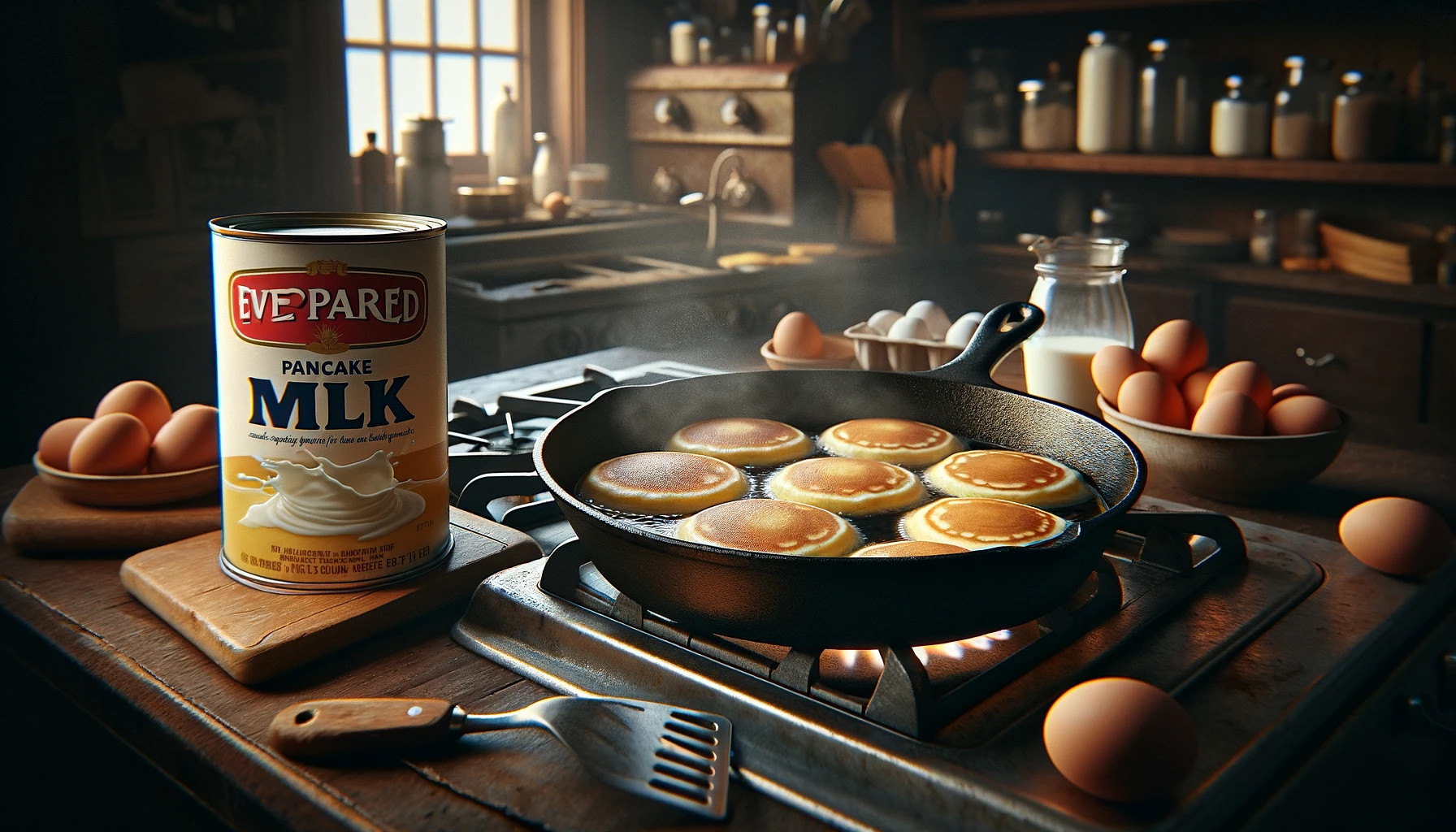
With its concentrated flavor and creamy texture, Evaporated milk can be a game-changer in pancake recipes.
Milk has been simmered down to remove about 60% of its water content, resulting in a richer and creamier product than regular milk.
Flavor Profile: Slightly caramelized due to the evaporation process, adding a depth of flavor that can enhance the overall taste of your pancakes.
Nutritional Benefits: Since it’s a concentrated form of milk, it’s higher in nutrients than regular milk. It provides calcium, protein, and vitamins D and A in more concentrated amounts.
How to Use It: To substitute evaporated milk for regular milk in pancakes, mix it with an equal amount of water to dilute it back to the consistency of regular milk. This means if your recipe calls for 1 cup of milk, use ½ cup of evaporated milk mixed with ½ cup of water.
A pro tip:
Evaporated milk can add a wonderful richness to your pancakes, making them taste even more indulgent without being overly heavy.
10. Condensed Milk: The Sweet Sensation
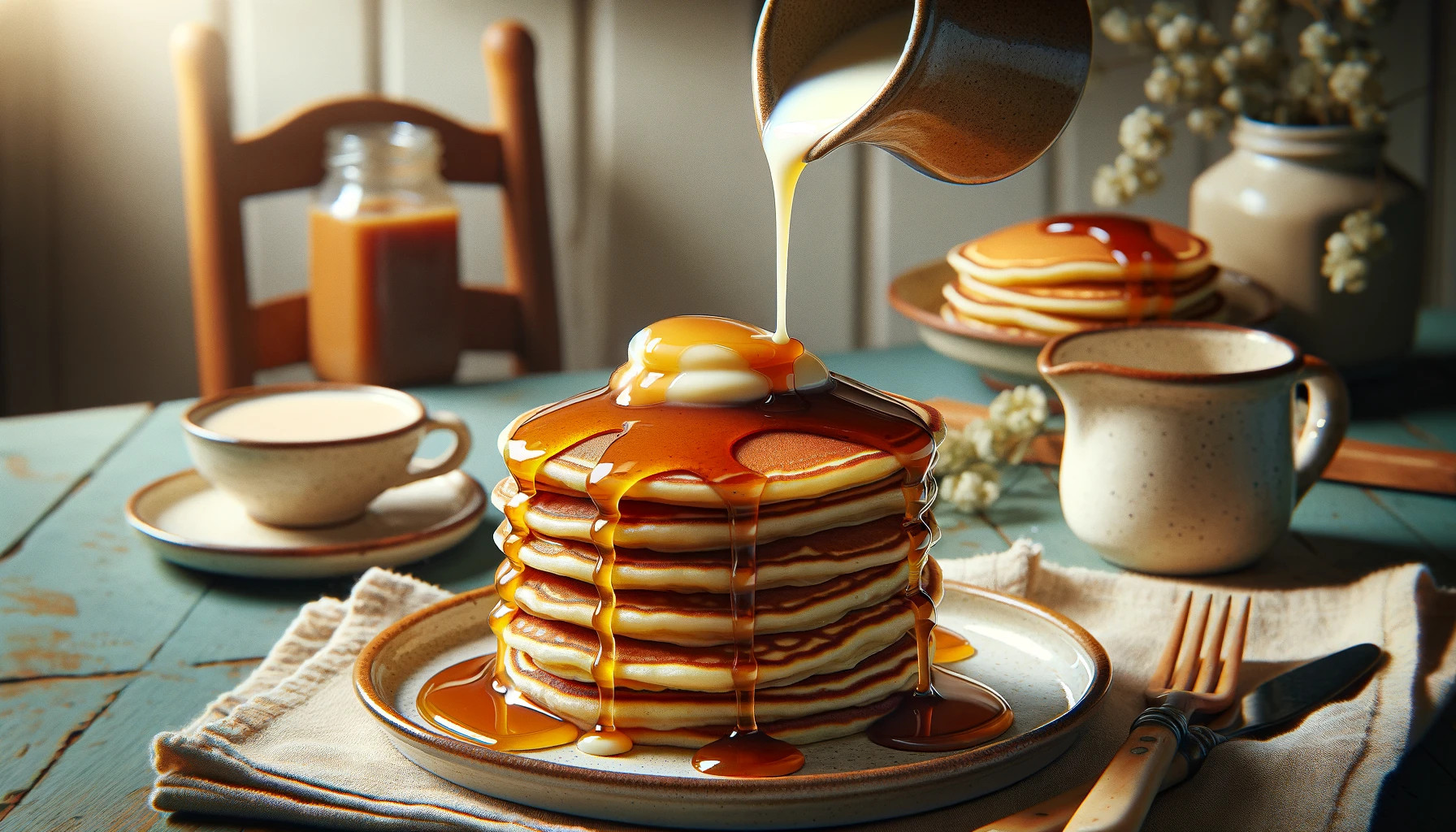
Sweetened condensed milk is a thicker, sweeter version of evaporated milk with sugar added.
It’s an unconventional choice for pancakes but can be a delightful addition if you want to infuse sweetness into the batter directly.
Flavor Profile: Rich, creamy, and sweet, it can transform your pancakes into a dessert-like treat.
Nutritional Benefits: While it’s rich in calories and sugar, condensed milk also offers a dose of calcium and protein. It’s a treat meant for occasional indulgence rather than daily nutrition.
How to Use It: Due to its sweetness, you’ll want to reduce the amount of sugar in your pancake recipe if using sweetened condensed milk. Use it sparingly, replacing half the milk in the recipe with an equal amount of diluted condensed milk (half condensed milk, half water).
Here’s something to try:
A small amount of sweetened condensed milk in your batter can create a caramel-like flavor for special breakfast occasions.
11. Sour Cream: The Tangy Twist
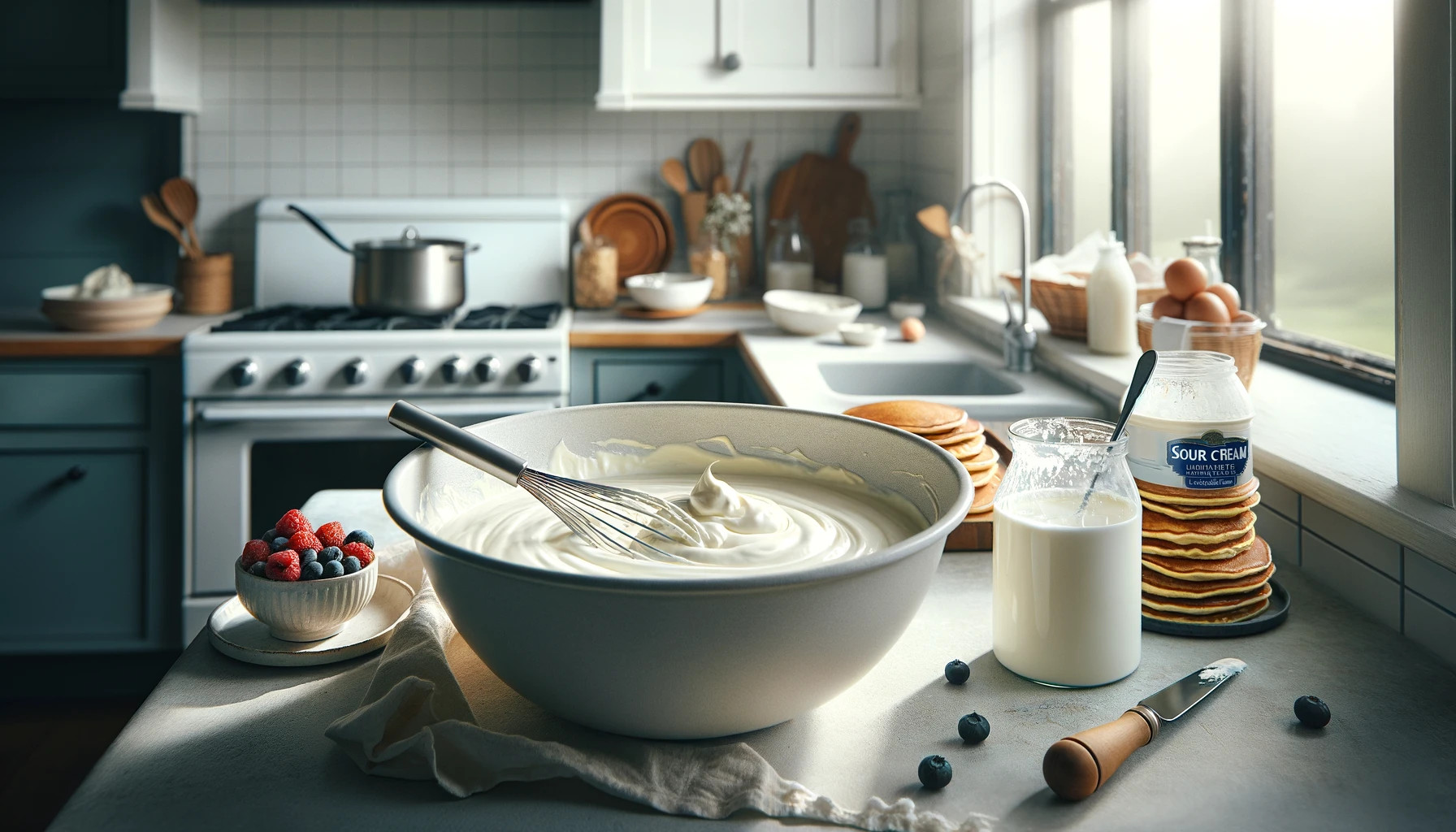
Sour cream might seem unlikely for pancake batter, but its acidity and creaminess can produce incredibly tender and fluffy pancakes with a subtle tang.
Flavor Profile: Adds a rich tanginess that can balance the sweetness of your pancakes, offering a sophisticated flavor profile.
Nutritional Benefits: It’s rich in fats, contributing to the moist texture of pancakes. Additionally, sour cream contains probiotics that can be beneficial for digestive health.
How to Use It: Replace half of the milk called for in your recipe with sour cream or use it in a one-to-one ratio for a richer texture. The acidity in sour cream can also help activate the baking soda or baking powder in the batter, making even fluffier pancakes.
Chef’s insight:
Mixing sour cream with a bit of milk or water can lighten its consistency, making it easier to incorporate into the batter without losing the benefits of its rich texture and flavor.
Incorporating these alternatives into your pancake recipes adds a twist to your traditional breakfast fare and invites a delightful exploration of flavors and textures.
Whether you’re reaching for the creamy decadence of evaporated milk, the sweet indulgence of condensed milk, or the tangy richness of sour cream, each option promises to transform your pancakes into a dish that’s anything but ordinary.
How to Substitute Milk in Pancake Recipes

When substituting milk in pancake recipes, use a 1:1 ratio for most milk alternatives (like almond, soy, oat, and cashew milk).
If using coconut milk from a can, start with a smaller amount and adjust to achieve the desired batter consistency due to its thickness.
You might want to add a little extra fat to the mix for water.
Easy Milk-Substitute Pancake Recipe
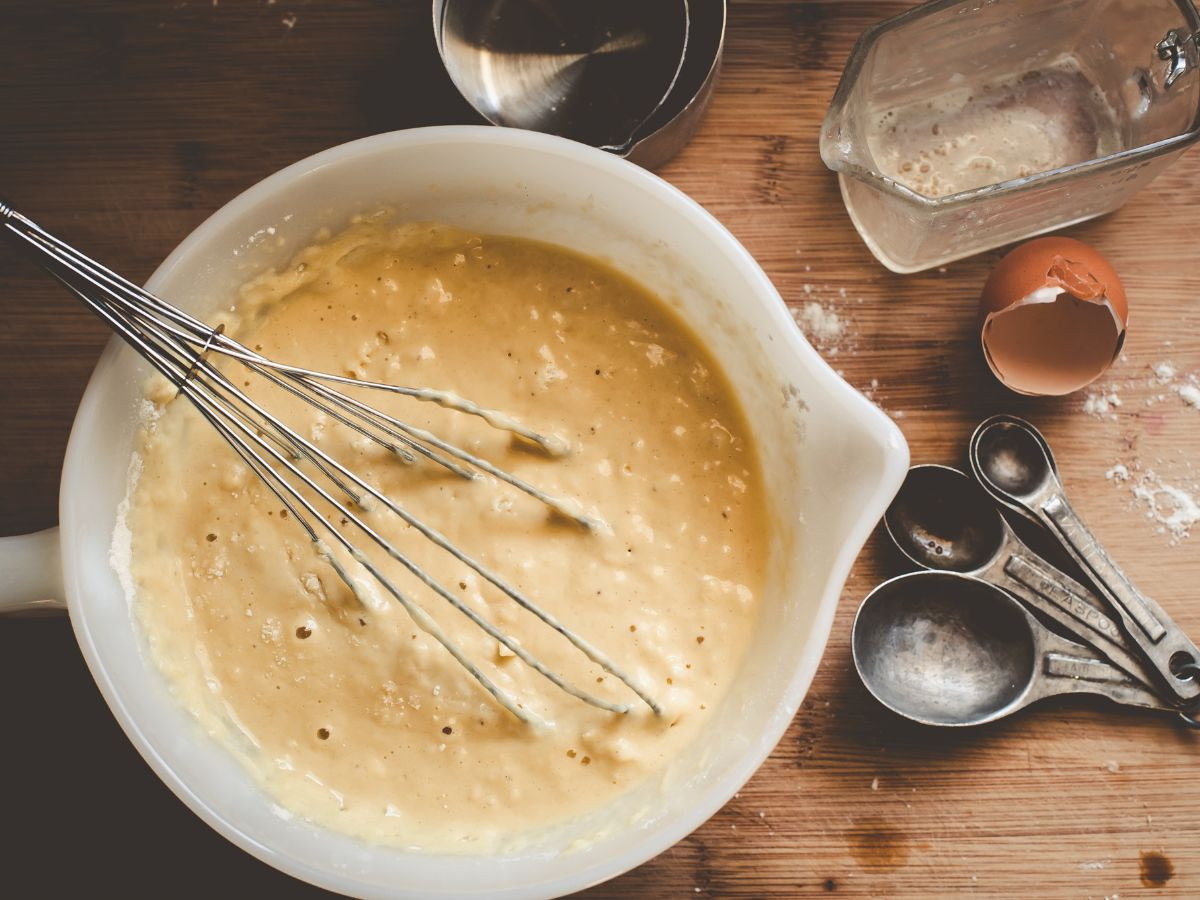
Here’s a simple pancake recipe that’s designed to be versatile with any milk substitute:
Ingredients:
1 cup all-purpose flour
2 tablespoons sugar
2 teaspoons baking powder
1/2 teaspoon salt
1 cup milk substitute (any from the list above)
2 tablespoons melted butter or oil
1 egg
1 teaspoon vanilla extract (optional)
Instructions:
Mix Dry Ingredients: In a large bowl, whisk together the flour, sugar, baking powder, and salt.
Combine Wet Ingredients: In another bowl, beat the egg, then mix in the milk substitute, melted butter (or oil), and vanilla extract.
Combine Wet and Dry Ingredients: Pour the wet ingredients into the dry ingredients. Stir until combined; it’s okay if the batter is lumpy.
Cook the Pancakes: Heat a lightly greased skillet over medium heat. Pour 1/4 cup of batter for each pancake. Cook until bubbles form on the surface, then flip and cook until golden brown.
This recipe is a fantastic base for any milk substitute, allowing you to enjoy delicious pancakes regardless of dietary preferences or needs.
Feel free to add your favorite mix-ins like blueberries, chocolate chips, maple syrup, or bananas to make your breakfast even more special.
A Dairy-Free Conclusion
Each milk substitute we’ve explored offers its own unique twist on the classic pancake, ensuring that dietary restrictions, health preferences, or a simple shortage of milk never stand in the way of a delightful breakfast.
Whether you’re reaching for the creamy decadence of evaporated milk, the sweet indulgence of condensed milk, or the tangy richness of sour cream, each option promises to transform your great-tasting pancakes into a dish that’s anything but ordinary.
From the nutty undertones of almond and cashew milk to the tropical richness of coconut milk and even the surprising simplicity of water, a world of flavors is waiting to be poured onto your griddle.
Embracing these alternatives diversifies your breakfast repertoire and invites you to experiment with new textures and tastes.
So, if you’re after the creaminess of oat milk, the protein punch of soy milk, or the earthy notes of hemp milk, there’s an option to suit every palate when using dairy-free pancakes or a solid dairy milk pancake.
And let’s not forget the nutritional benefits—ranging from omega-rich flaxseed milk to low-calorie almond milk; these substitutes allow you to tailor your pancakes to your dietary needs without compromising taste.
FAQ and Additional Information
Can I use water instead of milk in pancakes?
You can use water instead of milk in homemade pancake recipes and boxed mixes.
While milk is traditionally used in pancake recipes for its flavor, fat content, and the tender texture it lends to the batter, water is a perfectly viable substitute in a pinch.
Advantages of Using Water
Simplicity: Water is a straightforward substitute that doesn’t alter the flavor profile of your pancakes.
Allergy-Friendly: It’s ideal for those with dairy allergies or lactose intolerance.
Vegan: Water is suitable for vegan diets, making it an excellent choice for avoiding animal products.
Calorie Reduction: Using water instead of milk can lower the calorie content of your pancakes.
Considerations and Tips
Texture and Flavor: Since water doesn’t contain the fats and sugars present in milk, pancakes made with water might be less flavorful and tender.
To compensate, you might want to add more oil or melted butter to the batter to introduce some fat, which helps improve the texture and richness.
Leavening Agent: Ensure your recipe includes a leavening agent like baking powder or baking soda. The interaction between these and the wet ingredients will help achieve a rise and fluffiness in your homemade pancakes.
Flavor Enhancements: Consider adding vanilla extract, lemon juice, cinnamon, or a pinch of salt to enhance the flavor of your pancakes since water won’t contribute to any taste.
How to Use Water in Pancake Batter
To substitute water for milk in pancake recipes, use a 1:1 ratio. If your recipe calls for 1 cup of milk, simply use 1 cup of water instead. Be mindful of the batter’s consistency; it should be pourable but not too runny.
Adjust with extra flour or water as needed to achieve the right texture.
While milk adds richness and depth to pancakes, water is a surprisingly effective substitute that ensures your cooked pancakes are still on the table, even when you’re out of milk or accommodating dietary restrictions.
With a few tweaks for flavor and texture, you can enjoy delicious pancakes that cater to a wide range of dietary needs and preferences. You can also mix water with powdered milk.
Can I use water instead of milk in Aunt Jemima pancake mix?
Pancake mixes like Aunt Jemima are designed to be versatile and accommodating to various dietary needs and pantry shortages. Using water instead of milk will still produce pancakes, but there are a few differences to note:
Texture and Flavor: Milk contributes to pancakes’ richness, flavor, and tenderness. Using water instead may result in slightly less flavorful and rich pancakes. However, they will still be enjoyable, especially with your favorite toppings.
Adjustments: If you’re using water, consider adding more oil or melted butter to the batter if possible. This can help add some richness to the pancakes that milk would typically provide.
Ease and Convenience: Water is a straightforward substitute that simplifies the pancake-making process and is an excellent option if you’re out of milk or need to avoid dairy for any reason.
The preparation instructions on pancake mixes are usually quite flexible, allowing for substitutions like water instead of milk. Just follow the mix-to-water ratio recommended on the packaging for best results. If the instructions specifically mention milk, you can replace it with equal water.






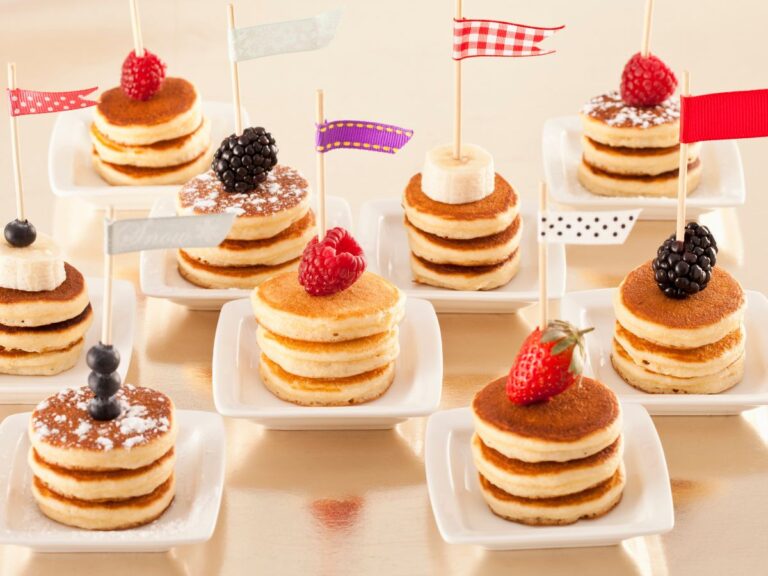

That was an awesome recipe! Thank you for the trouble you have gone to so I don’t have to. Amazing pancakes. I tried the Coconut Milk substitute. Next time I will give Cashew Milk a try. Thanks again. Brilliant!
Thank You So Much, and You are so very welcome! I love your website!